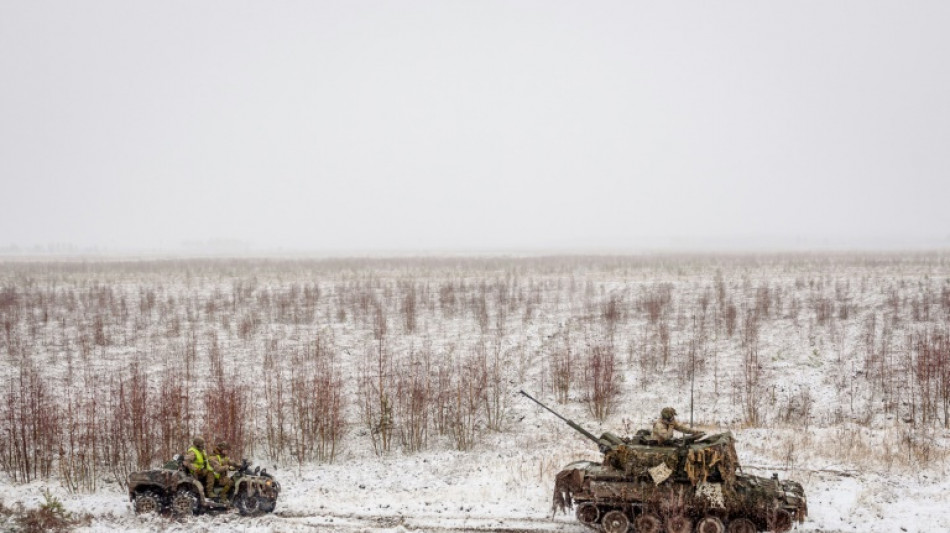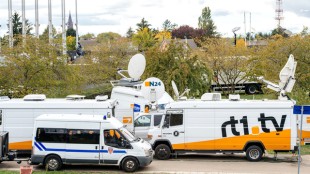
-
 French readers lap up Sarkozy's prison diaries
French readers lap up Sarkozy's prison diaries
-
UK PM warns Abramovich 'clock is ticking' over Chelsea sale fund

-
 Warner Bros. Discovery rejects Paramount bid
Warner Bros. Discovery rejects Paramount bid
-
Winners of 2026 World Cup to pocket $50 million in prize money

-
 World no. 1 Alcaraz ends 'incredible ride' with coach Ferrero
World no. 1 Alcaraz ends 'incredible ride' with coach Ferrero
-
World number one Alcaraz announces 'difficult' split with coach Ferrero

-
 Iran boxer sentenced to death at 'imminent' risk of execution: rights groups
Iran boxer sentenced to death at 'imminent' risk of execution: rights groups
-
Snicko operator admits error that led to Carey's Ashes reprieve

-
 Finland PM apologises to Asian countries over MPs' mocking posts
Finland PM apologises to Asian countries over MPs' mocking posts
-
Doctors in England go on strike for 14th time

-
 Romania journalists back media outlet that sparked graft protests
Romania journalists back media outlet that sparked graft protests
-
Rob Reiner's son awaiting court appearance on murder charges

-
 Ghana's Highlife finds its rhythm on UNESCO world stage
Ghana's Highlife finds its rhythm on UNESCO world stage
-
Stocks gain as traders bet on interest rate moves

-
 France probes 'foreign interference' after malware found on ferry
France probes 'foreign interference' after malware found on ferry
-
Europe's Ariane 6 rocket puts EU navigation satellites in orbit

-
 Bleak end to the year as German business morale drops
Bleak end to the year as German business morale drops
-
Hundreds queue at Louvre museum as strike vote delays opening

-
 Bondi shooting shocks, angers Australia's Jewish community
Bondi shooting shocks, angers Australia's Jewish community
-
Markets rise even as US jobs data fail to boost rate cut bets

-
 Senegal talisman Mane overcame grief to become an African icon
Senegal talisman Mane overcame grief to become an African icon
-
Carey pays tribute to late father after home Ashes century

-
 'Many lessons to be learned' from Winter Games preparations, says ski chief
'Many lessons to be learned' from Winter Games preparations, says ski chief
-
Emotional Carey slams ton to give Australia upper hand in 3rd Ashes Test

-
 Asian markets mixed as US jobs data fails to boost rate cut hopes
Asian markets mixed as US jobs data fails to boost rate cut hopes
-
Carey slams ton as Australia seize upper hand in third Ashes Test

-
 Bondi shooting shocks, angers Australia Jewish community
Bondi shooting shocks, angers Australia Jewish community
-
Myanmar junta seeks to prosecute hundreds for election 'disruption'

-
 West Indies hope Christmas comes early in must-win New Zealand Test
West Indies hope Christmas comes early in must-win New Zealand Test
-
Knicks beat Spurs in NBA Cup final to end 52-year trophy drought

-
 Khawaja revels in late lifeline as Australia 194-5 in 3rd Ashes Test
Khawaja revels in late lifeline as Australia 194-5 in 3rd Ashes Test
-
Grief and fear as Sydney's Jewish community mourns 'Bondi rabbi'

-
 Trump orders blockade of 'sanctioned' Venezuela oil tankers
Trump orders blockade of 'sanctioned' Venezuela oil tankers
-
Brazil Senate to debate bill to slash Bolsonaro jail term

-
 New Zealand ex-top cop avoids jail time for child abuse, bestiality offences
New Zealand ex-top cop avoids jail time for child abuse, bestiality offences
-
Eurovision facing fractious 2026 as unity unravels

-
 'Extremely exciting': the ice cores that could help save glaciers
'Extremely exciting': the ice cores that could help save glaciers
-
Asian markets drift as US jobs data fails to boost rate cut hopes

-
 What we know about Trump's $10 billion BBC lawsuit
What we know about Trump's $10 billion BBC lawsuit
-
Ukraine's lost generation caught in 'eternal lockdown'

-
 'Catastrophic mismatch': Safety fears as Jake Paul faces Anthony Joshua
'Catastrophic mismatch': Safety fears as Jake Paul faces Anthony Joshua
-
Australia's Steve Smith ruled out of third Ashes Test

-
 Khawaja grabs lifeline as Australia reach 94-2 in 3rd Ashes Test
Khawaja grabs lifeline as Australia reach 94-2 in 3rd Ashes Test
-
Undefeated boxing great Crawford announces retirement

-
 Trump says orders blockade of 'sanctioned' Venezuela oil tankers
Trump says orders blockade of 'sanctioned' Venezuela oil tankers
-
UK experiences sunniest year on record

-
 Australia holds first funeral for Bondi Beach attack victims
Australia holds first funeral for Bondi Beach attack victims
-
FIFA announces $60 World Cup tickets after pricing backlash

-
 Maresca relishes support of Chelsea fans after difficult week
Maresca relishes support of Chelsea fans after difficult week
-
Medical Care Technologies, Inc. (OTC Pink:MDCE) Announces Completion of AI-Based Consumer App, Now in iOS App Store Review


NATO trains to help its own, as Ukraine war rumbles
Any resemblance to reality is purely coincidental. As war rages in Ukraine, NATO and its partners will launch exercises in Norway on Monday aimed at coming to the rescue of one of its own.
Some 30,000 troops, 200 aircraft and 50 vessels from 27 nations will take part in the Cold Response 2022 exercise, the largest exercise involving NATO troops this year.
Kicking off on March 14, the manoeuvres will enable Western nations to hone their combat skills in Norway's cold climate, including in the Arctic, on the ground, at sea and in the skies.
The exercise will be held just a few hundred kilometres from the Russian border, and while it was planned long before Moscow's invasion of Ukraine, it now has added significance because of the war.
"This exercise is extremely important for the security of Norway and its allies. We will practice an allied reinforcement of Norway", Norwegian Defence Minister Odd Roger Enoksen told AFP.
"It is not being held because of the Russian authorities' attack on Ukraine, but given the backdrop there is a heightened significance", he said.
The guardian of NATO's northern border in Europe, Norway is keen to test how it would manage Allied reinforcements on its soil, in line with Article 5 of NATO's charter, which requires member states to come to the aid of another member state under attack.
Neighbouring Sweden and Finland, which are officially military non-aligned but increasingly close partners of NATO, will also participate in Cold Response, which will conclude on April 1.
- Avoid misunderstandings -
"I find it totally normal, perhaps now more than ever, to train together to demonstrate our capacity and our willingness to defend our values and our way of life", stressed General Yngve Odlo, head of Norway's Joint Headquarters and in charge of Cold Response.
On the Russian side of the 196-kilometre (121-mile) Arctic border that separates it from Norway is the Kola Peninsula, home to the Northern Fleet and a large number of nuclear weapons and military installations.
"There is no explicit military threat against NATO or Norwegian territory", Enoksen said, but "the situation in Europe is more unpredictable than it has been in a long time."
To avoid any misunderstandings, Norway has informed Russia of the Cold Response exercise -- defined as "purely defensive" -- and will keep a respectful distance from Russia.
General Odlo spoke to Vice Admiral Alexander Moiseyev, commander of Russia's Northern Fleet, at length about the exercise in order to provide reassurances.
Russia declined however an invitation to send observers to the exercise.
"Any build-up of NATO military capabilities near Russia's borders does not help to strengthen security in the region", the Russian embassy in Norway told AFP.
In similar circumstances in the past, Moscow has expressed its discontent by jamming GPS signals or announcing missile tests, thereby blocking access to some international maritime and air space.
- 'Rugged conditions' -
Russia's offensive against Ukraine surprised experts, leaving some to wonder whether Russian President Vladimir Putin would try to go after other former Soviet states, such as the Baltics, in his quest to restore the old USSR.
Cold Response "allows us to hone our training, demonstrate our unity, our willingness to work together in rugged conditions which may be conditions that are more familiar in the east", French General Yvan Gouriou of France's rapid reaction corps said.
"So the exercise is very relevant in the current situation", he added.
More than 40,000 troops were initially expected to participate in Cold Response, but the number has shrunk due to the Covid pandemic and geopolitical crises elsewhere.
The US aircraft carrier Harry Truman and its escort ships have been kept back in the Aegean Sea, where they are helping monitor the skies near Ukraine.
T.Sanchez--AT
